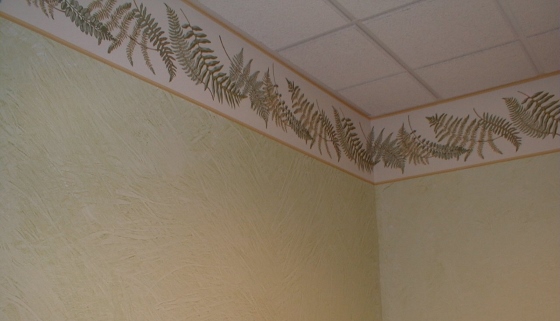Rag Painting

The rag painting process creates a look similar to that of rich leather on wall surfaces. Up close the wall looks like a child tried to paint it.
DEAR TIM: I saw a segment on television that showed how one could create a unique look on interior walls using colored glaze and rags. Is this method really as attractive as it looks? Is there an easy way to do the job? Rolling a rag down a wall looks like hard work to me. Are there any trade secrets you are willing to share about the process? Amy G., Lexington, KY
DEAR AMY: The rag faux painting look on walls is absolutely spectacular. I can assure you that it will take the breath away from all of your friends and neighbors who come by to see the completed job. They will beg you for the name of the painter that did it. You will be astounded at how simple it is to create this look.
The rag painting process creates a look similar to that of rich leather on wall surfaces. Up close the wall looks like a child tried to paint it. The overall wall color looks mottled and uneven. But when you stand back eight or ten feet, the surface looks rich and tantalizing. The effect is achieved when translucent glaze is applied over regular wall paint. Glazes can be applied clear for different effects but look best when they are tinted with color.
The key is to pick the correct background color and a complimentary glaze color. Certain paint stores have color combinations that have already been selected by decorating professionals. You can do your own custom colors if you like so that you can match furniture or curtain fabrics. That is what I recently did in my own basement. My glaze color matches a certain highlight color in my couch fabric.
Before you rag roll, you must paint the walls a base color. This is typically a light color that is in the same color family as the glaze. For example, the base color of my walls is an extremely light green color. It is basically an off-white. The glaze I used is a medium green that looks very close to the color of a lime rind. The base color is almost always a flat paint and must dry at least 24 hours before applying the glaze.
Using rags to create the effect is a tough job in my opinion. I found a unique rag roller cover that fits onto a standard paint roller frame. This rag roller has a twisted fabric that fits over a plastic tube that slides onto the roller frame. The roller is dipped into the glaze just as you would dip a standard roller cover into paint. The twisted fabric creates random high and low spots on the roller. As you roll the glaze onto the wall it applies the glaze unevenly. This is precisely the effect you want. The trick is to roll the rag roller around to spread the glaze so that it is a very thin film. Do not roll as you would ordinary paint. The more random and wild the roller strokes the better.
The glaze is a little tricky to work with. It can flash dry in as little as 90 to 120 seconds. If this happens you will have ugly overlap areas where you overlap the glaze as you proceed sideways or up and down a wall. The trick is to keep a wet edge on the glaze so this does not happen. Use a special glaze extender product that you mix with the glaze to slow down the drying time. The extenders look like a milky liquid but will not alter the color of the glaze. They will usually give you an extra 10 minutes of working time but certainly no more. You must move quickly and do an entire wall at once.
The glaze must not be allowed to get on wall surfaces that have yet to be rolled or have previously been rolled. Wet glaze applied over dried glaze looks horrible since it appears so much darker than a single coat. Inside wall corners need to be taped with special masking tape that has low tack adhesive that will not damage the fresh wall paint. The tape prevents glaze from getting onto the wall that has yet to be done. A paint brush dipped in glaze that is dabbed into the corners will help finish wall surfaces that the rag roller can not easily cover.
One of the benefits of the rag roll glaze technique is the washability of the wall surface. The glaze dries with a slightly glossy appearance. If you get dirt or spills on the wall, they are quite easy to clean off. If the wall gets scratched or dented you can repair it if you work carefully. The trick is to touch up the scratch or gouge only. Do not let any base coat paint or glaze get on the undamaged wall surfaces.
Column 384